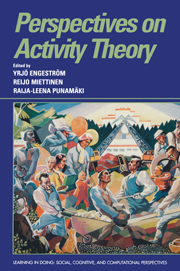Book contents
- Frontmatter
- Contents
- List of contributors
- Series foreword
- Introduction
- Part I Theoretical issues
- Part II Language and its acquisition
- 11 The expanded dialogic sphere: Writing activity and authoring of self in Japanese classrooms
- 12 Improvement of schoolchildren's reading and writing ability through the formation of linguistic awareness
- 13 Psychomotor and socioemotional processes in literacy acquisition: Results of an ongoing case study involving a nonvocal cerebral palsic young man
- Part III Play, learning, and instruction
- Part IV Technology and work
- Part V Therapy and addiction
- Author index
- Subject index
11 - The expanded dialogic sphere: Writing activity and authoring of self in Japanese classrooms
Published online by Cambridge University Press: 05 June 2012
- Frontmatter
- Contents
- List of contributors
- Series foreword
- Introduction
- Part I Theoretical issues
- Part II Language and its acquisition
- 11 The expanded dialogic sphere: Writing activity and authoring of self in Japanese classrooms
- 12 Improvement of schoolchildren's reading and writing ability through the formation of linguistic awareness
- 13 Psychomotor and socioemotional processes in literacy acquisition: Results of an ongoing case study involving a nonvocal cerebral palsic young man
- Part III Play, learning, and instruction
- Part IV Technology and work
- Part V Therapy and addiction
- Author index
- Subject index
Summary
Introduction
Writing is a multifunctional activity. Writing enables us to send messages to or receive information from people displaced in time and space. With the aid of written symbols, we can regulate our own actions and behaviors in the future. Among the various functions of writing, however, I would like to focus on the function of constructing a dialogic sphere. The following composition, which illustrates this function, was written by a second-grade girl in a Japanese elementary school.
Example 1
TADPOLE IS A BABY FROG
Today, we decided that we were going to keep tadpoles in our classroom. I know that a tadpole is a baby frog but I don't know it really. Tomoki said we would see hind legs first but Naomi insisted that forelegs and hind legs grow out at the same time.
Mr. Kuwabara [the teacher of the class] didn't know what to answer. I'm really looking forward to seeing how the tadpoles would grow.
This composition, taken for a classroom journal, is a typical example of writing in the Japanese classroom. Its most characteristic feature is that it is writer-based (Britton, 1977; Kitagawa & Kitagawa, 1987). It is not an autonomous text, as characterized by Olson (1977), but one dependent on the classroom community in which children and teachers share experience and senses.
The composition cannot be seen merely as a report of classroom discussion. It cannot be read as a mere memorandum for future activity, either.
- Type
- Chapter
- Information
- Perspectives on Activity Theory , pp. 165 - 182Publisher: Cambridge University PressPrint publication year: 1999
- 4
- Cited by



